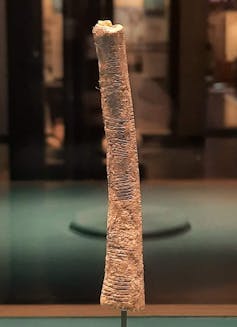Almost 60 million years ago, a series of natural events—including volcanic eruptions, erosion, glacial movement, and sea level rise—created Northern Ireland’s Giant’s Causeway: a coastal area made of over 40,000 hexagonal basalt stone pillars. Today it is a world-renowned tourist destination, and the hundreds of thousands of yearly visitors are leaving their mark—but not in a good way.
In a recent statement, the conservation charity National Trust is appealing to visitors to stop wedging coins between the Giant’s Causeway’s basalt rock columns. The coins are corroding and physically damaging the World Heritage Site, and as such, accelerating natural erosion processes, according to a report by the British Geological Survey.
From countless padlocks on Parisian bridges to coins tossed into Rome’s Trevi Fountain each year, tourists seem obsessed with the idea of leaving something behind at iconic landmarks. But while the Catholic charity Caritas collected $1.52 million in 2022 from the Trevi fountain, the National Trust and its partners will have to spend over $40,000 to remove coins from the Giant’s Causeway.

“We know some may want to leave a token of their visit, but the coins are causing damage and we are urging people to stop the practice and to leave no trace so this natural wonder remains special for future generations,” Cliff Henry, National Trust Nature Engagement Officer at the Giant’s Causeway, said in the statement. “The coins are rusting, and expanding to three times their original thickness, which puts huge pressure on the surrounding rock causing it to crumble. Unsightly streaks of copper, nickel and iron oxides are also staining the stones where the coins are corroding.”
The report found coins from around the world lodged in difficult-to-reach places, suggesting visitors put themselves at risk in the process. It also highlights, however, that people don’t seem to be aware that their actions are damaging to the site.
“There is demonstrable evidence that the practice of inserting coins into the joints and other fractures of the Giant’s Causeway is having a detrimental impact on the constituent basalt rock, both physically and aesthetically,” reads the British Geological Survey report. “The processes associated with the degradation of the coins are seemingly accelerating the break-up of the Causeway rock mass that occurs naturally through physical and chemical weathering.”

According to legend, an Irish giant named Finn McCool (yes, that was his last name) built a causeway across the Irish Sea in order to fight with a Scottish giant, who subsequently destroyed it as he fled back to his homeland. Another myth, however, has it that the Irish giant actually built the causeway to reach a woman he’d fallen in love with. Either way, I doubt McCool would have appreciated his masterpiece falling to ruins in the hands of tourists.






















































